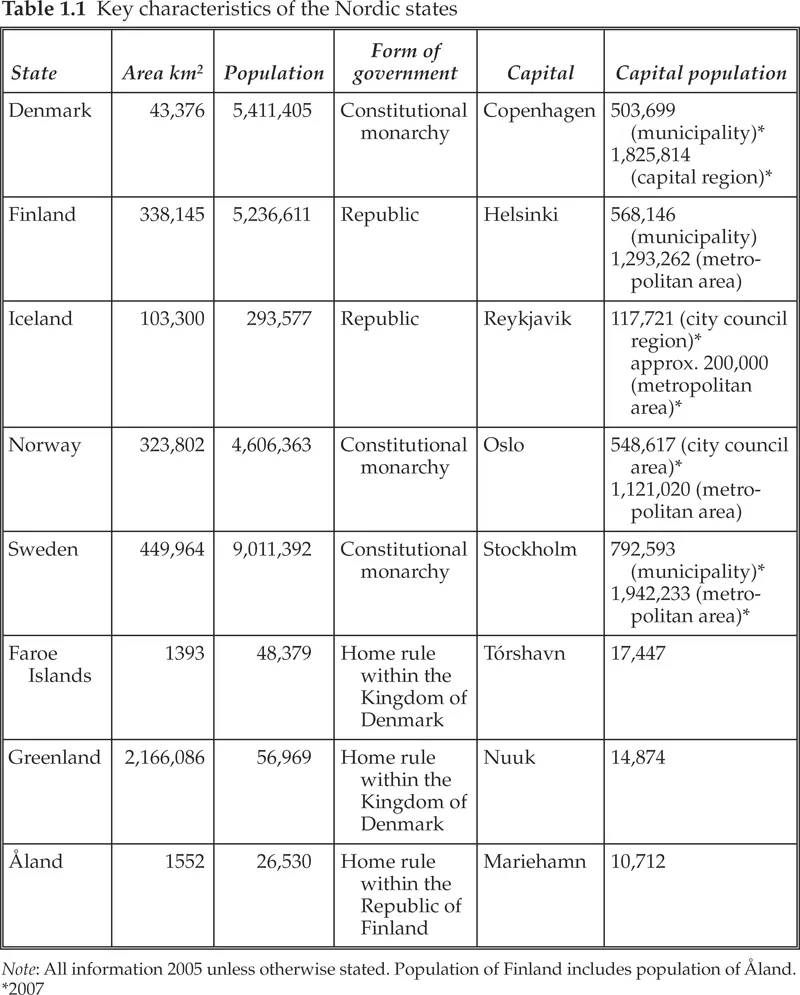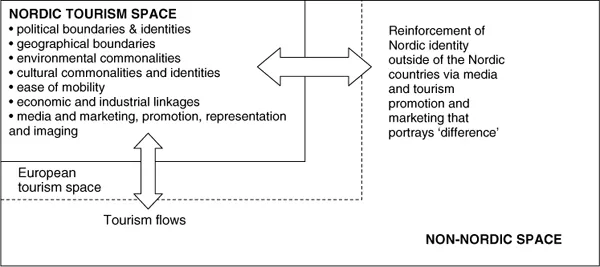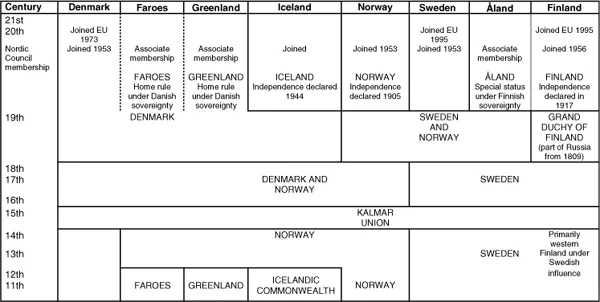![]()
Chapter 1
Nordic Tourism: Introduction to Key Concepts
Learning Objectives
After reading this chapter, you should be able to:
• Understand the concept of the Nordic countries and region.
• Understand key concepts of tourism and mobility.
• Identify the key elements in the tourism system.
Introduction
This first chapter will provide a broad introduction to the Nordic countries and their autonomous regions: Denmark, Faeroe Islands, Finland, Åland, Greenland, Norway, Iceland and Sweden. The chapter also provides an introduction to some of the key concepts that will be used in the book such as domestic and international tourism, trip, and tourism industry.
The Nordic Concept
In Asia there are hundreds of millions whose image of the Nordic Region is still unformed – a canvas with only a few dots, if any. Therefore, the Nordic Region, finally encompassing all shores of the Baltic Sea, has what it takes to satisfy an intelligent traveller from the polluted industrial centres of China and Japan: Nature and wilderness, culture and history. Luckily, mass tourism can never be our forte. We Nordics have a far more satisfying challenge: To meet and surpass the expectations of the truly demanding traveller. It can be done by exploiting our image to the full – prejudices and misunderstandings included. (Toivanen, 2006: 354)
The term ‘nordic’ refers to the countries of northern Europe: Denmark, Finland, Iceland, Norway and Sweden and the associated territories of Greenland, Faroe Islands and the Åland islands (Table 1.1). The term is derived from the Scandinavian language equivalent of Norden, which is Pohjola or Pohjoismaat in the Finnish language, meaning northern or northern countries. However, the term does not just refer to a geographical space but is also a reference point to a political space, primarily occupied in institutional terms by the Nordic Council; a cultural space, in terms of common elements of a northern identity, as well as the related historical linkages and relationships between the various territories; and an economic space, with respect to the economic agreements that link the countries as well as the substantial intra-regional trade that occurs. Finally, related to the various ways in which the Nordic idea is understood, as well as the openness of movement between the Nordic countries, is the tourism space of the Nordic countries.
Figure 1.1 Nordic tourism space
The notion of a distinct Nordic tourism space is obviously a major focus for this book with such a space being both internally and externally defined (Figure 1.1). Internally such a space has been determined by a number of political, cultural and economic factors that have led to the development of substantial intra-regional and cross-border travel, while there is also a substantial commonality of approach with respect to state involvement in tourism development, especially in peripheral areas, that reflects a common social democratic tradition. Externally the various elements of Nordic identity are reinforced through the media as well as via tourism specific promotion and marketing. In addition, from a global perspective the countries of the Nordic region are an important inbound and outbound market in their own right with several significant international tourism businesses including SAS Airlines and Finnair. Furthermore, the Nordic region has also contributed to innovations in tourism business, education and research which also reinforce the importance of a specific examination of Nordic tourism.
Cases and issues 1.1: Nordic is not Scandinavia!
In English the term ‘Scandinavia’ is often incorrectly used with reference to the Nordic countries. The term Scandinavia was originally applied in the 16th century to the countries that then occupied the Scandinavian peninsula: Norway, Sweden and Denmark. However, Denmark ceased having territory on the Peninsula from 1658, while Finland ceased being a part of Sweden in 1809. The Scandinavian peninsula, Denmark, Iceland, Scandinavian Greenland and the Faroes (along with the Shetland and Orkney Islands, and the Isle of Man and other parts of Ireland and Britain) did share a common linguistic, cultural and religious environment as late at the high Middle Ages, and many commonalities remain, but they are geographically separate. Indeed, geologically Greenland is part of North America! Present-day Finland is also not part of geographic Scandinavia and although it was part of Sweden from the 15th to the early 19th century. In terms of language, Finnish, is also completely separate from the Scandinavian languages belonging instead to the Finno-Ugric/Uralic languages together with the languages of the Sami, the indigenous people of far northern Europe. However, the extent to which the region shares a common history can be indicated by there being a significant Swedish speaking minority in Finland (approximately 6%) and Finnish minorities in Sweden and Norway.
The Nordic idea is one that has emerged over time as a result of political and cultural interrelationships (Figure 1.2). At various times the countries have been linked under a common government or crown although it was only in the 15th century at the time of the Kalmar Union that that the territories were united. For much of the last thousand years the Nordic region has been marked by substantial political rivalry between the various countries and especially between Denmark and Sweden. External political influence in the region has also been prominent with respect to Russia, which controlled Finland for most of the 19th century and early 20th century and, to a lesser extent, the UK and Germany. However, since Finnish independence, and especially in the post Second World War period, the region has been marked by peace and substantial cooperation. In fact, the region has some of the most open borders in the world, further reinforcing its tourism identity.
Figure 1.2 Political history of the Nordic countries from the 11th century to the present-day
Under the Nordic Passport Union, any citizen can travel between the Nordic countries without having passports checked, with an identity card being sufficient. Other citizens can also travel between the Nordic countries’ borders without having their passport checked, but they still have to carry a passport or other kinds of approved travel identification papers. Hence, the membership of Denmark, Sweden and Finland in the European Union did not provide any major changes, particularly since even Norway and Iceland signed the Schengen agreement abolishing systematic border controls within Europe. Such relative openness obviously raises questions as to how international and domestic tourism can be defined, and it is to these issues that the chapter will now turn.
What is Tourism? Definitions of Key Concepts
Conceptualisation is critical for a culture of high-quality information and for creating knowledge. It is hard to develop and work with tourism statistics and statistics-based information in the absence of distinct conceptualisation which has been firmly grounded with both the producer and the user of the information. (Nortek, 2007: 4)
Tourism is a concept that while initially looks very easy to define is actually quite complicated. Much of the problem with con...



